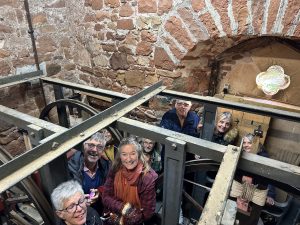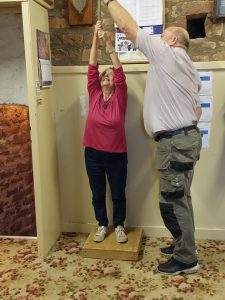
Adventure group climb St Gregory’s church tower
 In November the Adventure Group didn’t venture very far. In fact, they visited a place which is very familiar to most of us, if only from the outside. St Gregory’s Church tower is one of the most prominent landmarks in the town but I think it would be safe to say that only a very few of us have ever been to the top. The plan was to see the view over the town and surrounding countryside, but also to learn about bell ringing and try it out for ourselves.
In November the Adventure Group didn’t venture very far. In fact, they visited a place which is very familiar to most of us, if only from the outside. St Gregory’s Church tower is one of the most prominent landmarks in the town but I think it would be safe to say that only a very few of us have ever been to the top. The plan was to see the view over the town and surrounding countryside, but also to learn about bell ringing and try it out for ourselves.
 Before we embarked on the climb, Deborah Wallis gave us a very interesting introduction to the history of bell ringing, as well as some of the technical aspects involved. Deborah is a member of the bell ringing team at St Gregory’s and has been an active ringer since her teens. The style and tradition of bell ringing in this country is very different from most other countries. Elsewhere, church bells are little more than a resounding ‘clanging’ of bells to announce the start of a church service. In England, however, from about the 16th century, there developed a different tradition whereby the sequence of notes changes to create different ‘tunes’. This contributes to the traditional English ‘soundscape’ which is so evocative. We also learned something of how bells are made, and how they are hung and rung. Obviously, they are very heavy and safety is a vital consideration, so there is a lot of interesting engineering work involved. Today, there is only one bell foundry still functioning in the UK – Taylors of Loughborough – but in earlier ages, the bells would have been made very close to the church itself as it would be a major undertaking to transport a bell any significant distance.
Before we embarked on the climb, Deborah Wallis gave us a very interesting introduction to the history of bell ringing, as well as some of the technical aspects involved. Deborah is a member of the bell ringing team at St Gregory’s and has been an active ringer since her teens. The style and tradition of bell ringing in this country is very different from most other countries. Elsewhere, church bells are little more than a resounding ‘clanging’ of bells to announce the start of a church service. In England, however, from about the 16th century, there developed a different tradition whereby the sequence of notes changes to create different ‘tunes’. This contributes to the traditional English ‘soundscape’ which is so evocative. We also learned something of how bells are made, and how they are hung and rung. Obviously, they are very heavy and safety is a vital consideration, so there is a lot of interesting engineering work involved. Today, there is only one bell foundry still functioning in the UK – Taylors of Loughborough – but in earlier ages, the bells would have been made very close to the church itself as it would be a major undertaking to transport a bell any significant distance.
 To reach the top of the tower we had to navigate a narrow spiral staircase. Those who lacked inches on this occasion had an advantage as we had to deal with some very tight doorways and confined spaces. The view from the top was worth it. Fortunately, visibility was excellent and there was no rain or wind, so we could take our time exploring Dawlish from this fine vantage point.
To reach the top of the tower we had to navigate a narrow spiral staircase. Those who lacked inches on this occasion had an advantage as we had to deal with some very tight doorways and confined spaces. The view from the top was worth it. Fortunately, visibility was excellent and there was no rain or wind, so we could take our time exploring Dawlish from this fine vantage point.
 We then had to return halfway down the tower to see the bells at close quarters. It was a challenge fitting us into the chamber, clambering over the supports and squeezing in among the bells. It was certainly an experience to be so close to these bells, some of which were made in the 18th century, and the machinery which makes them all work.
We then had to return halfway down the tower to see the bells at close quarters. It was a challenge fitting us into the chamber, clambering over the supports and squeezing in among the bells. It was certainly an experience to be so close to these bells, some of which were made in the 18th century, and the machinery which makes them all work.
 It was then our turn to try it out for ourselves, having been given some excellent tuition. Most of us were surprised by how little effort is required; more important are timing, concentration and teamwork. It was very satisfying to be able to ring the bells at a very basic level, maintaining a smooth rhythm. It is just as well that it does not take too much effort as a full peal with eight bells takes about three hours. Unsurprisingly, ringing a full peal is reserved for special occasions such as coronations and royal weddings: for more ‘routine’ bell ringing, shorter sequences are more usual. As part of the tradition of bellringing, a visit to the pub afterwards is customary! It’s thirsty work.
It was then our turn to try it out for ourselves, having been given some excellent tuition. Most of us were surprised by how little effort is required; more important are timing, concentration and teamwork. It was very satisfying to be able to ring the bells at a very basic level, maintaining a smooth rhythm. It is just as well that it does not take too much effort as a full peal with eight bells takes about three hours. Unsurprisingly, ringing a full peal is reserved for special occasions such as coronations and royal weddings: for more ‘routine’ bell ringing, shorter sequences are more usual. As part of the tradition of bellringing, a visit to the pub afterwards is customary! It’s thirsty work.
There were more members wanting to take part in this adventure than there were spaces, so a second event has been planned for December 15th. Please see here for further details.
Deborah also says that anyone who wishes to have another go at bell ringing, perhaps to consider joining the St Gregory’s team, would be very welcome. She would be very pleased if you would contact her if you would like to know more.
John Vick
Photo credits: Pete Thorogood and John Vick
